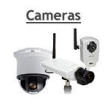
|
|
|
iCatcher Help
Learn how to set up and use iCatcher's features to their full potential. read more... File download areaDownload all the iCatcher software products, including legacy versions. read more... Wildlife picture galleryi-Catcher Wildlife captures fantastic scenes from nature. Have a look at some of the best. read more... Capture equipmentFind out about suitable equipment for use with iCatcher, from cameras to lighting, and more. read more... |
The Console Bar The Console Bar is organized into different sections that control various aspects of iCatcher's operation. System statusThe top 'System status' section shows the LCD status panel, the start/stop button and the user/lock options. Console can be temporarily stopped using the stop button to recover processing time if other intensive tasks are running. The 'Lock' button can be used to prevent changes being made to Console settings as well as preventing Console from being shut down. Its use requires an administrative user to have been configured in the Users settings. The LCD status panel alternates through various mini screens to show the current system time, the uptime, remote users, total frames per second being processed and the available disk space on the history (recordings) drive. The cycling can be configured under the look and feel settings. The panel also shows a scrolling bar graph of the amount of motion being detected across the whole system, and an indication of the running state of iCatcher Console. Console treeThe next section contains the tree list and shows all the connected cameras and other components that have been configured. At the top of this list is 'Local Console', which can be renamed as appropriate. Under Local Console, are the different definable groups of cameras, as well as the master 'All Cameras' group which can not be removed or renamed. Right clicking on the Local Console gives you access to the web view, system optimisation, the evidence CD creator, synchronised playback, new cameras and groups, and system settings. Groups can be created by right-clicking on 'Local Console' and selecting New Group. User-defined groups can be renamed by right-clicking on them and selecting 'Rename' while 'Delete' can be used to remove unwanted camera groups (this does not remove the items in the group). You can also add cameras or I/O devices to groups by dragging from their current location in the tree. Please note that the "All cameras" group will be hidden by default after other groups have been added. Each camera group (including All cameras) has Show All Cameras and Hide All Cameras options to make management of groups of cameras easier. Feed options include Show feed, Bring to top which flashes the window for easy identification, and access to the playback and motion map. You can also access the feed settings, masks, alerts, and device configuration. Sensors & Automation lists all the configured I/O devices and allows you to set the state of any output device. Please see the I/O devices help for more information. Analytics has entries for tripwire counters, showing the feed name and counter ID along with its total value, and motion maps for each feed. Right clicking either will allow you to reset or reconfigure it. iDomain allows quick and easy access to any other Console available over the network or internet, both for live views and playback and to see their status. The tree also contains plan views, along with easy access to the Gallery, user configuration and iCatcher support. Moving camerasIf the currently selected Feed in the Feed tree is a PTZ capable camera, then the PTZ controls on the Console Bar will be enabled. Using these controls you can use the arrows to Pan and Tilt around the scene. The central 'H' will return you to the configured home position and the + and - buttons to the right of the Pan/Tilt arrows allow you to control the zoom. This is described in detail under Controlling PTZ cameras. Auto arrange & LayoutThe layout panel allow you to auto-arrange all the windows on screen, and to save and revert to your own defined window layouts. Within the Layout panel are 14 buttons. The top left button is the Auto Arrange button. Pressing this will organise the currently open windows on screen (or screens, if there is more than one monitor in use) and lay them out in a neat manner. The buttons labelled 1-12 are for saving your own custom layouts. If you have manually arranged your on-screen windows and wish to save the layout, holding down the CTRL key whilst clicking a button will save the layout to that button. If you then move the windows around, clicking the button you saved the layout to will revert all the windows to their saved positions. Buttons with layouts already saved to them are shown with a bold number, and the last layout loaded will be underlined. The bottom left button allows you to configure layout cycling to automatically switch between saved layouts. You can specify the interval between switching, as well as which layouts are included in the cycling. You can also disable automatic cycling and switch between them manually. System configurationThe System configuration panel allow you to configure iCatcher Console. This is described in detail under Configuring iCatcher. This section also includes the ability to arm or disarm the alerting. |
